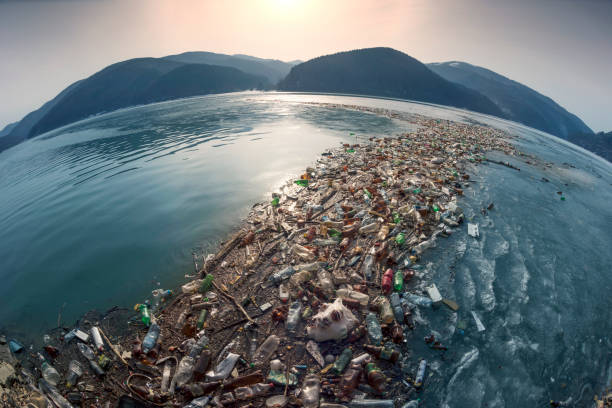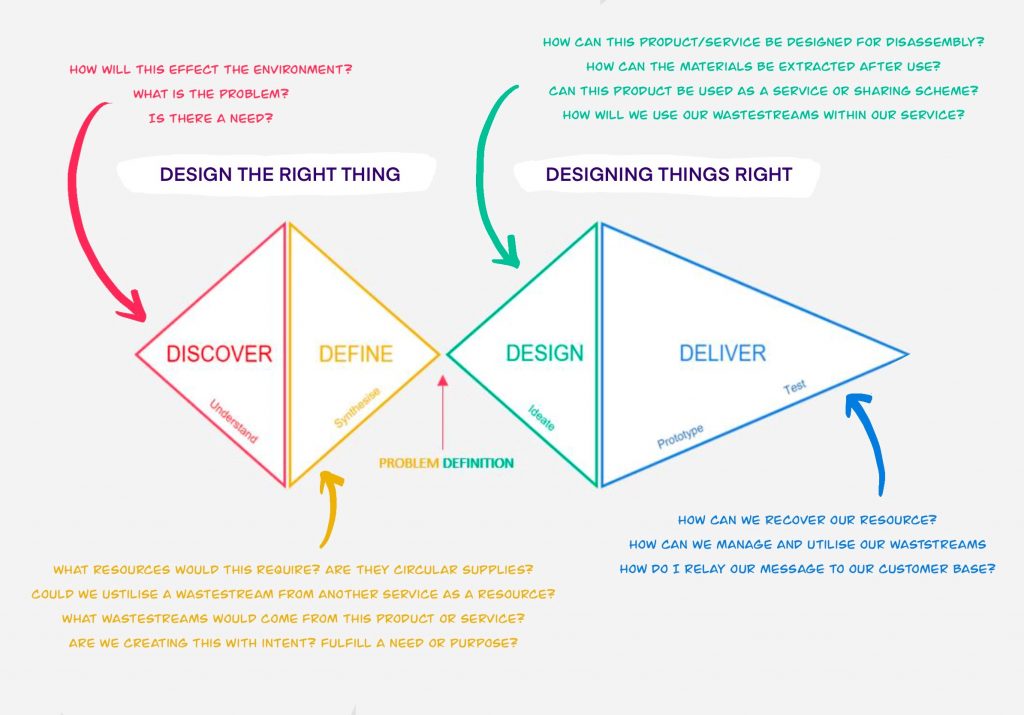
The great pacific garbage patch is just one example that shows you the extent of the damage waste is having on the environment. When buying products or interacting with a service it is easy to forget the effect that you will have on the environment and that waste lasts a lot longer past the moment you dispose of it. Sustainability in design only tackles a portion of the problem. To create drastic change through design we must also focus on circularity of our products and services.
Sustainability in design and the circular economy.
The philosophical definition of the word circular is the ‘logical fallacy in which the reasoner begins with what they are trying to end with.’ Blending this with the definition of economy ‘the careful management of available resources’ truly encapsulates the overarching principle of the circular economy.
The foundations of circular economy regarding design can be simplified down to three salient principles:
- Viewing waste as a secondary resource
- Designing for disassembly and/or re-use
- Creating with intent
The circular economy is all about creating a systemic shift in how we take, make, and consume. In times like this where resources are becoming increasingly finite and landfills are polluting the world, innovation is needed to find creative solutions for how we use and redefine waste as a secondary resource. When waste is looked at as a resource, the materials that are initially used to produce a product can be retrieved after use and retain a value. Shifting your mindset to view waste as a resource allows you to remember that that product or service, even at its end of life, still holds inherent value and can be utilised in some way. By considering the use, disposal and/or retrieval of materials and products at their end-of-life, it diminishes the need to extract more primary resources. These materials that used to be looked at as ‘waste’, can start being looked at as an opportunity.
Ask yourself why do you throw things away? Convenience? Ignorance? Social conformity? Whatever the reason, how we view waste needs to change.
Consumer values are changing.
Historically a lot of companies and manufacturers have prioritised overconsumption and profit over the environment. Whilst consumer preferences are shifting and people are beginning to prioritise brands that put sustainability at the forefront, although this is a positive change, so called ‘sustainable recyclable’ products and services are unfortunately no longer enough in the current climate crisis. For instance, Greenpeace reports that less than 10% of everyday plastic gets recycled – ‘You shouldn’t stop recycling – but recycling alone isn’t the solution.’
The onus is no longer on the consumer, but on companies, manufacturers, and governments to prevent overconsumption, overexploitation, and the production of single use products.
Greenpeace states:
“The problem isn’t that people aren’t recycling enough. The problem is that there is still far too much throwaway plastic being produced.”
The linear take-make-consume industrial model is not only wasteful and damaging to our environment, but it is also no longer a reliable or viable production model due to rapid population growth, increase in customer base size, resource scarcity, food, and water insecurity etc.
Generation Z is setting the example for consumers that prioritise products and services that are sustainable. A study conducted by University of Pennsylvania found that Generation Z has ‘outsized influence’ on Generation X and Boomer elders regarding sustainable shopping. Reporting that nearly 90% of Gen X consumers would be willing to spend an extra 10% or more for sustainable products, up from just over 34% two years ago. This influence will continue to grow as Generation Z grow older, they will not only continue to influence the older generation but pass on their knowledge to new generations.
Now consumer values are changing, there are many more companies doing innovative and creative things to make it easy for their customers to lead sustainable lives. Whether that’s through the design of their service or their product, they have created with intent and actively chosen to uphold circular principles and strategies whilst designing. For example: Phillips, Rent the runway, Patagonia, Home things, Zipcar, Tala, Lush.
Sustainable strategies.
Experts have looked for solutions to update the way in which we consume. Employing these sustainable strategies requires us to alter the ways we use resources, products and dispose at the end-of-life. Here are a few circular economy business models and strategies that companies have integrated to shift into a circular future:
- CIRCULAR SUPPLIES: finding and investing in new circular solutions to supply needs. E.g., investing in plant protein for sustainable vegan meat alternative.
- RESOURCE RECOVERY: Using waste as a secondary resource. Using incentivised returns to ensure that companies get the opportunity to retrieve materials from broken products.
- PRODUCT LIFE EXTENSION: eliminating planned obsolescence and extending product lifespan through repairing, upgrading, and remarketing.
- SHARING PLATFORMS: Sharing of products and assets that have a low use rate, maximising the use of products through sharing which enhances productivity and value creation.
- PRODUCTS AS A SERVICE: Using products through a lease or pay for use arrangement versus buy to own – access vs ownership.
- ECO DESIGN: Applying the principles of cradle-to-cradle design to product or service produced. Designing for disassembly and with intent.
The ExperienceLab way.
We work using the double diamond framework which is based on a combination of divergent and convergent thinking across four stages (see figure 1).
- Discover: understanding the extent of the problem.
- Define: using insight to define the challenge.
- Develop: investigate solutions to the challenge.
- Deliver: testing different solutions to find the one that will work.
By systematically moving from discovery through to delivery, we work with companies to investigate how their customers feel about circularity and sustainability of their current product or service and what improvements can be made; we support companies in understanding their target market and their sustainability needs; we can aid the development and testing of adding or changing circular features of products or services.
So, how do we as researchers and designers mirror circular thinking into design thinking? Here is an idea of how we apply circular thinking to the double diamond framework in order to deliver products and services that are truly circular whilst remaining viable, feasible and desirable to the user.

Turning the tide will take time.
It is integral that we as designers make a conscious decision to design with intent and consistently apply circular principles to everything we create; it is the only way to ensure that we will have a positive lasting effect on the planet. Conversely, it is the responsibility of the consumer to maintain pressure and hold companies accountable for their environmental impact. It is foreseen that products that are not circular will not be viable in the future, so the faster we embark on a dedicated journey to lead and enable circular lives the sooner we will have a positive impact on the planet.


